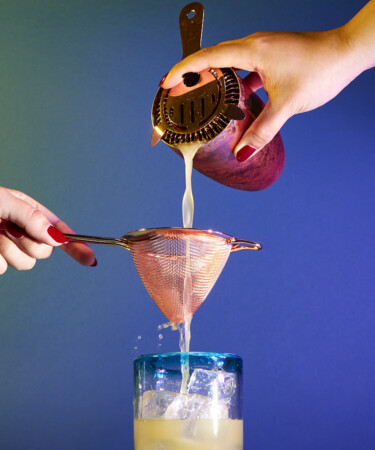Any standard beginner’s cocktail kit will likely come equipped with a Hawthorne strainer, that handy, spring-loaded tool that keeps fruit pulp, herbs, and shards of ice from making their way into your glass as you serve your drink. That said, wander into any respectable cocktail bar these days and you may notice the bartender holding a tiny, cone-shaped strainer between the cocktail glass and the shaker. What you’re watching is double-straining in action.
Is it essential? Not necessarily, but depending on what you’re making, double-straining can take a cocktail from good to extraordinary. And the method doesn’t just protect your drink from unsightly dregs; there are extra benefits to this simple step that can go unrealized to the untrained eye. We sat down with Misha Chavez, bartender at NYC’s Lullaby and founder of upcoming Brooklyn bar pop-up The Museum, to get the 411 on what double-straining brings to the bar.
What Is Double-Straining?
It’s exactly what it sounds like: straining a drink twice. A standard Hawthorne strainer will keep most of your drink’s disposable ingredients from getting into the glass after shaking, but the key word here is “most.” A second, smaller strainer can help catch even smaller pieces of ice, pulp, or herbs before they taint your finished drink.
“You still get all the flavor, but you’re not having any debris coming through,” Chavez explains.
Why Double-Strain?
Double-straining can make for a smoother, more potent, and more integrated cocktail. When single-straining, some ice shards may fall through and sit on top of the cocktail, meaning the first sip — arguably the most important one — may be a little crunchy.
“Unless the drink is getting served over ice, [single-straining] does dramatically change the texture and the flavor when those ice chips are in there, because you’re immediately going to be watering down every sip, especially when you have something like a Naked and Famous or a Daiquiri,” Chavez says.
The practice also comes in handy for speed purposes behind the stick — or if you’ve been put on cocktail duty at a house party. It may sound counterintuitive, but according to Chavez, “you can’t pour as fast with just the Hawthorne strainer without spilling a little bit. If I’m slammed on a Friday or Saturday night and I want a Margarita in the glass as fast as possible, I just dump it out of my [shaker] tins with my double-strainers, and it’s perfectly strained with way less mess.”
When to Double-Strain
While any shaken drink can benefit from an extra round of straining, there are some cocktails that can really benefit from the extra care. Double-straining drinks served “up” is wise since they’re ice-free and already diluted post-shake, but it can still be beneficial to double-strain drinks served on the rocks, like a Margarita.
“In that first sip of a Margarita, you don’t want those little ice crystals,” Chavez says. “That’s the reason why we pour over fresh ice. Otherwise, you might as well just dump it all in without straining.”
Double-straining is especially paramount when creating egg-white cocktails, though, which develop a thicker-than-normal layer of foam on top.
“You have big bubbles, you have small bubbles — it’s super chaotic,” Chavez says of the froth. “When you double-strain egg-white cocktails, it takes those bigger bubbles and makes them smaller and tighter. You end up with a more uniform, delicate, soft foam. It goes from something like a soda to a mousse.”
Some foam will inevitably get lost in that second strain, but that’s the point. “You want them to have a creamy mouthfeel,” Chavez points out. “When you’re sending it through a fine-strainer, it results in a really wonderful creaminess that you don’t get otherwise.”
When Not to Double-Strain
Aside from frozen drinks, which need no straining at all, it’s counterintuitive to double-strain stirred cocktails. Very little aeration is generated during the stirring process, and the ice in a mixing glass doesn’t shatter like it does inside a shaker.
“The concern I would have for double-straining a stirred cocktail would be that it would take away from that silky texture,” Chavez says. “The whole point of stirring is integral to creating a very smooth drinking experience.” To guarantee the optimal silkiness in stirred builds, Chavez recommends performing a single strain through a julep strainer, which has a series of small holes for the cocktail to pass through compared to the super-fine coil of a Hawthorne.
How to Double-Strain
Now that we’ve established when to double-strain your cocktails, let’s break down exactly how to do it sans spillage. To try it, pick up a small mesh strainer like this one — you’ll usually find them for under $10 online or at most home-goods stores.
First, “close the gate” by locking the Hawthorne strainer into your shaker tin. Then, with your fine mesh strainer positioned directly over the glass in one hand, pour the contents of your shaker tin through the mesh and into the glass. Once all the liquid is out of the shaker tin, you can tap the mesh strainer a few times with the bottom of the tin to help any lingering liquid to pass through. “The good thing about double-straining is that as long as everything’s passing through the mesh, it’s catching everything,” Chavez says. If you fancy a bit of flair, feel free to hold the shaker tin high above the second strainer while pouring, but be careful.
“It doesn’t matter how high you’re holding the tin, but I would keep the fine strainer close to the cocktail so you’re not spilling anything,” Chavez says. “It’s relatively fool-proof, and that’s the nice thing about it.”
